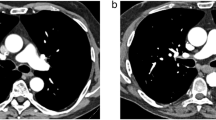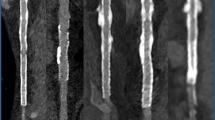Abstract
Objectives
We aimed to develop a Japanese normal database for specific acquisition conditions, to compare US and Japanese normal populations, and to examine effects of camera rotation angle range on the normal limits.
Methods and Results
Stress-rest 99mTc myocardial perfusion databases for 360° (Jp360) and 180° (Jp180) acquisitions were created by the working group activity of the Japanese Society of Nuclear Medicine using Japanese patients. A standard 180° database (US180) had been previously generated by the Cedars Sinai Medical Center based on American patients. Additionally, 90 Japanese patients underwent coronary arteriography and stress-rest 99mTc perfusion study with 360° acquisition for validation purposes, and quantitative evaluation was performed by QPS software using the above three normal database sets. Major differences between US180 and Jp360 databases were found in the apex and in the anterior wall in females and in the inferior wall in males. When the diagnostic performance was evaluated by receiver-operating characteristic analysis, area under the curve was the highest for Jp360 (0.842), followed by Jp180 (0.758) and US180 (0.728) databases (P = .019, Jp360 vs US180; P = .035, Jp360 vs Jp180). The coronary territory score at stress was highest with the Jp360 database in male patients with right coronary artery stenosis (n = 26, Jp360: 4.92 ± 4.61 [mean ± SD], Jp180: 4.23 ± 4.29, US180: 2.92 ± 3.53; P < .0001 between Jp360 and US180) and in female patients with left anterior descending artery stenosis (n = 12, Jp360: 6.33 ± 4.76, Jp180: 5.25 ± 4.83, US180: 4.50 ± 4.15; P = .0076 between Jp360 and US180).
Conclusion
Because of the differences between US and Japanese normal databases, it is essential to use population- and acquisition-specific databases when using quantitative perfusion SPECT software.




Similar content being viewed by others
References
Klocke FJ, Baird MG, Lorell BH, Bateman TM, Messer JV, Berman DS, et al. ACC/AHA/ASNC guidelines for the clinical use of cardiac radionuclide imaging—executive summary: A report of the American College of Cardiology/American Heart Association Task Force on Practice Guidelines (ACC/AHA/ASNC Committee to revise the 1995 guidelines for the clinical use of cardiac radionuclide imaging). Circulation 2003;108:1404-18.
Germano G, Kavanagh PB, Slomka PJ, Van Kriekinge SD, Pollard G, Berman DS. Quantitation in gated perfusion SPECT imaging: The Cedars-Sinai approach. J Nucl Cardiol 2007;14:433-54.
Garcia EV, Faber TL, Cooke CD, Folks RD, Chen J, Santana C. The increasing role of quantification in clinical nuclear cardiology: The Emory approach. J Nucl Cardiol 2007;14:420-32.
Ficaro EP, Lee BC, Kritzman JN, Corbett JR. Corridor4DM: The Michigan method for quantitative nuclear cardiology. J Nucl Cardiol 2007;14:455-65.
Slomka PJ, Nishina H, Berman DS, Akincioglu C, Abidov A, Friedman JD, et al. Automated quantification of myocardial perfusion SPECT using simplified normal limits. J Nucl Cardiol 2005;12:66-77.
Nakajima K, Kusuoka H, Nishimura S, Yamashina A, Nishimura T. Normal limits of ejection fraction and volumes determined by gated SPECT in clinically normal patients without cardiac events: A study based on the J-ACCESS database. Eur J Nucl Med Mol Imaging 2007;34:1088-96.
Nakajima K, Kumita S, Ishida Y, Momose M, Hashimoto J, Morita K, et al. Creation and characterization of Japanese standards for myocardial perfusion SPECT: Database from the Japanese Society of Nuclear Medicine Working Group. Ann Nucl Med 2007;21:505-11.
Germano G, Kiat H, Kavanagh PB, Moriel M, Mazzanti M, Su HT, et al. Automatic quantification of ejection fraction from gated myocardial perfusion SPECT. J Nucl Med 1995;36:2138-47.
Nishina H, Slomka PJ, Abidov A, Yoda S, Akincioglu C, Kang X, et al. Combined supine and prone quantitative myocardial perfusion SPECT: Method development and clinical validation in patients with no known coronary artery disease. J Nucl Med 2006;47:51-8.
Germano G, Kavanagh PB, Waechter P, Areeda J, Van Kriekinge S, Sharir T, et al. A new algorithm for the quantitation of myocardial perfusion SPECT. I: Technical principles and reproducibility. J Nucl Med 2000;41:712-9.
Slomka PJ, Nishina H, Berman DS, Kang X, Friedman JD, Hayes SW, et al. Automatic quantification of myocardial perfusion stress-rest change: A new measure of ischemia. J Nucl Med 2004;45:183-91.
Akhter N, Nakajima K, Okuda K, Yoneyama T, Matsuo S, Taki J, et al. Regional wall thickening in gated myocardial perfusion SPECT in a Japanese population: Effect of sex, radiotracer, rotation angles and frame rates. Eur J Nucl Med Mol Imaging 2008;35:1608–15.
Knollmann D, Knebel I, Koch KC, Gebhard M, Krohn T, Buell U, et al. Comparison of SSS and SRS calculated from normal databases provided by QPS and 4D-MSPECT manufacturers and from identical institutional normals. Eur J Nucl Med Mol Imaging 2008;35:311-8.
Eisner RL, Tamas MJ, Cloninger K, Shonkoff D, Oates JA, Gober AM, et al. Normal SPECT thallium-201 bull’s-eye display: Gender differences. J Nucl Med 1988;29:1901-9.
Van Train KF, Areeda J, Garcia EV, Cooke CD, Maddahi J, Kiat H, et al. Quantitative same-day rest-stress technetium-99m-sestamibi SPECT: Definition and validation of stress normal limits and criteria for abnormality. J Nucl Med 1993;34:1494-502.
Slomka PJ, Nishina H, Abidov A, Hayes SW, Friedman JD, Berman DS, et al. Combined quantitative supine-prone myocardial perfusion SPECT improves detection of coronary artery disease and normalcy rates in women. J Nucl Cardiol 2007;14:44-52.
Berman DS, Kang X, Nishina H, Slomka PJ, Shaw LJ, Hayes SW, et al. Diagnostic accuracy of gated Tc-99m sestamibi stress myocardial perfusion SPECT with combined supine and prone acquisitions to detect coronary artery disease in obese and nonobese patients. J Nucl Cardiol 2006;13:191-201.
Grossman GB, Garcia EV, Bateman TM, Heller GV, Johnson LL, Folks RD, et al. Quantitative Tc-99m sestamibi attenuation-corrected SPECT: Development and multicenter trial validation of myocardial perfusion stress gender-independent normal database in an obese population. J Nucl Cardiol 2004;11:263-72.
Rivero A, Santana C, Folks RD, Esteves F, Verdes L, Esiashvili S, et al. Attenuation correction reveals gender-related differences in the normal values of transient ischemic dilation index in rest-exercise stress sestamibi myocardial perfusion imaging. J Nucl Cardiol 2006;13:338-44.
Slomka PJ, Fish MB, Lorenzo S, Nishina H, Gerlach J, Berman DS, et al. Simplified normal limits and automated quantitative assessment for attenuation-corrected myocardial perfusion SPECT. J Nucl Cardiol 2006;13:642-51.
Coleman RE, Jaszczak RJ, Cobb FR. Comparison of 180 degrees and 360 degrees data collection in thallium-20 1 imaging using single-photon emission computerized tomography (SPECT): Concise communication. J Nucl Med 1982;23:655-60.
Tamaki N, Mukai T, Ishii Y, Fujita T, Yamamoto K, Minato K, et al. Comparative study of thallium emission myocardial tomography with 180 degrees and 360 degrees data collection. J Nucl Med 1982;23:661-6.
Go RT, MacIntyre WJ, Houser TS, Pantoja M, O’Donnell JK, Feiglin DH, et al. Clinical evaluation of 360 degrees and 180 degrees data sampling techniques for transaxial SPECT thallium-201 myocardial perfusion imaging. J Nucl Med 1985;26:695-706.
Bice AN, Clausen M, Loncaric S, Wagner HN Jr. Comparison of transaxial resolution in 180 degrees and 360 degrees SPECT with a rotating scintillation camera. Eur J Nucl Med 1987;13:7-11.
Maublant JC, Peycelon P, Kwiatkowski F, Lusson JR, Standke RH, Veyre A. Comparison between 180 degrees and 360 degrees data collection in technetium-99m MIBI SPECT of the myocardium. J Nucl Med 1989;30:295-300.
Wolak A, Slomka PJ, Fish MB, Lorenzo S, Acampa W, Berman DS, et al. Quantitative myocardial-perfusion SPECT: Comparison of three state-of-the-art software packages. J Nucl Cardiol 2008;15:27-34.
Acknowledgment
We thank the many physicians and technologists who contributed to the accumulation and generation of the normal database. This work was performed using JSNM working group database 2007 and supported partly by Grants-in-Aid for Scientific Research in Japan (No.19591403). This research was also supported in part by a Grant, Number R01HL089765-01, from the NHLBI/NIH (PI: Piotr Slomka). Its contents are solely the responsibility of the authors and do not necessarily represent the official views of the NHLBI.
Disclosure: Cedars-Sinai Medical Center receives royalties for the licensure of QGS and QPS, a portion of which is distributed to some of the authors (GG, PS) of this manuscript.
Author information
Authors and Affiliations
Corresponding author
Appendix
Appendix
Participating hospitals and researchers for database accumulation are as follows:
Nippon Medical School Hospital (Shinichiro Kumita*, Yoshimitsu Fukushima), National Cardiovascular Center (Yoshio Ishida*), Keio University Hospital (Jun Hashimoto*), Tokyo Women’s Medical University (Mitsuru Momose*), Hokkaido University Hospital (Koichi Morita*, Masayuki Inubushi, Keiichiro Yoshinaga*), Toho University Omori Medical Center (Shohei Yamashina*), Toranomon Hospital (Hirotaka Maruno*), Nihon University School of Medicine (Naoya Matsumoto*), Kanazawa University Hospital (Koichi Okuda, Shinro Matsuo, Tatsuya Yoneyama, Junichi Taki*), Kanazawa Cardiovascular Center (Masaya Kawano)
* JSNM working group member
Rights and permissions
About this article
Cite this article
Nakajima, K., Okuda, K., Kawano, M. et al. The importance of population-specific normal database for quantification of myocardial ischemia: comparison between Japanese 360 and 180-degree databases and a US database. J. Nucl. Cardiol. 16, 422–430 (2009). https://doi.org/10.1007/s12350-009-9049-1
Received:
Revised:
Accepted:
Published:
Issue Date:
DOI: https://doi.org/10.1007/s12350-009-9049-1




